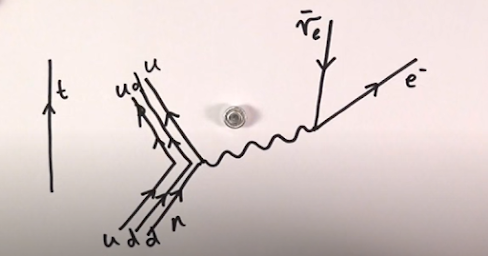Beta Decay
BETA DECAY
View my previous article here -
View the next article here -
-----------------------------------------
A particular type of radioactivity is known as beta-decay, which occurs in three forms known as beta-minus decay, beta-plus decay and electron capture. In each form, protons convert into neutrons, or vice-versa.
For instance, in beta-minus decay, one of the neutrons in a nucleus is converted into a proton with the emission of an electron and an electron antineutrino. This process may be written as:

As a neutron has the quark composition (udd) and a proton has the quark composition (uud), at the level of individual quarks, a beta-minus decay must involve a down quark converting into an up quark as follows:

This quark conversion, therefore, lies at the heart of all beta-minus decay processes. A quick check confirms that an electric charge is conserved in this process. The charge on the left-hand side of the equation is -(1/3) e, while the sum of the charges of the particles on the right-hand side is +(2/3) e - e + 0 = -(1/3) e also.
In beta-plus decay, a proton is converted into a neutron with the emission of a positron and an electron neutrino:

In electron capture, a proton is converted into a neutron when it captures an electron, and subsequently emits an electron neutrino:


As a neutron has the quark composition (udd) and a proton has the quark composition (uud), at the level of individual quarks, a beta-minus decay must involve a down quark converting into an up quark as follows:

This quark conversion, therefore, lies at the heart of all beta-minus decay processes. A quick check confirms that an electric charge is conserved in this process. The charge on the left-hand side of the equation is -(1/3) e, while the sum of the charges of the particles on the right-hand side is +(2/3) e - e + 0 = -(1/3) e also.
In beta-plus decay, a proton is converted into a neutron with the emission of a positron and an electron neutrino:

In electron capture, a proton is converted into a neutron when it captures an electron, and subsequently emits an electron neutrino:

-----------------------------------------
View the next article here -
View my previous article here -
View more structured order of the articles here -
-----------------------------------------
Feel free to ask/share anything additional in the comments section!
I am still learning Particle physics, but will try my best to answer your questions :)
Kindly let me know about any error here.
Kindly let me know about any error here.
You can also share anything additional for this article here.
View my previous article here -
View the next article here -
View more structured order of the articles here -
See more articles here -
Solve brain teasers! View my other blog here-
With Warm Wishes,
Lavanya

Comments
Post a Comment